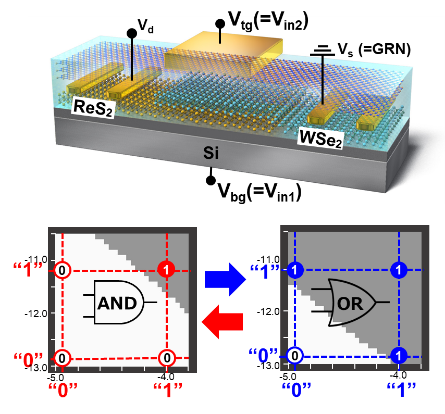Quantum Materials Field
Quantum Device Engineering Group
Designing next-generation device architectures using antiambipolar transistors
Group Leader: Yutaka Wakayama
Next-Generation Semiconductor, Nanostructures and devices
Current Topics
We investigated two types of in-memory logic operations: reconfigurable two-input logic circuits and multifunctional artificial synapses. These were realized in a dual-gate antiambipolar transistor with a ReS₂/WSe₂ heterojunction and a zinc phthalocyanine-cored polystyrene film as memory layer.

Fig. 1. Reconfigurable logic-in-memory circuits and multifunctional synapses using dual-gate AATs.
Outline of Research
We have been developing a new type of logic circuits to overcome the limits of modern von Neumann type device architectures. A key element is an antiambipolar transistor (AAT), where a p-n heterojunction plays critical role in controlling electrical currents. The uniqueness of AATs can be ascribed to their distinctive electrical properties; negative differential transconductance can be manipulated in the wide range of 101–104. By taking this advantage, we have developed multi-valued (ternary and quaternary) logic circuits, reconfigurable logic gates, optically controllable logic-in-memory and artificial synaptic devices. These logic operations have been developed with organic semiconductors and two-dimensional atomic layers.
References
- Y. Shingaya, T. Iwasaki, R. Hayakawa, S. Nakaharai, K. Watanabe, T. Taniguchi, J. Aimi, Y. Wakayama, ACS Appl. Mater. Interfaces 16 , 33769 (2024). DOI: 10.1021/acsami.4c06116
- Y. Shingaya, A. Zulkefli, T. Iwasaki, R. Hayakawa, S. Nakaharai, K. Watanabe, T. Taniguchi, Y. Wakayama, Adv. Electron. Mater. 9 , 2200704 (2022). DOI: 10.1002/aelm.202200704
Group members
-
 Yutaka Wakayama・Group Leader・Manager of Administrative Office
Yutaka Wakayama・Group Leader・Manager of Administrative Office -
 Ryoma Hayakawa・Principal Researcher
Ryoma Hayakawa・Principal Researcher
Activities
-
Feb. 22, 2024
-
Mar. 4, 2024
-
Mar. 15, 2024
-
May. 7, 2024
-
Jul. 22, 2024
-
Aug. 22, 2024
-
Sep. 12, 2024
-
Oct. 25, 2024
Links
-
Quantum Device Engineering Group (MANA official Website)
*The Quantum Device Engineering Group has been renamed the Semiconductor Functional Device group from April, 2025.


